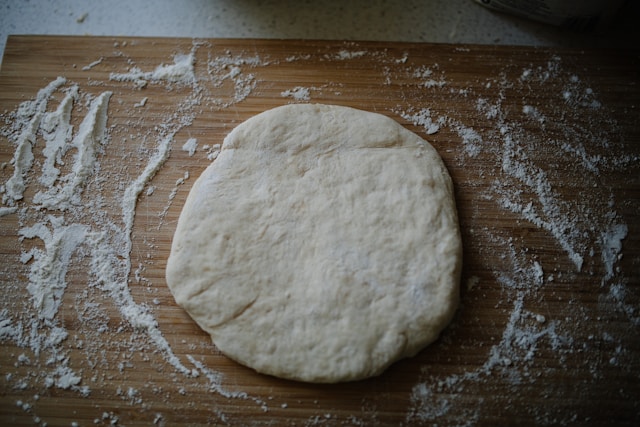What is Pizza Dough?
Pizza dough is the foundational element of every delicious pizza. It’s a simple mixture of flour, yeast, water, salt, and sometimes oil that, when properly prepared, creates the perfect base for your favorite toppings. The quality of the pizza dough can make or break your homemade pizza, so mastering the art of making the perfect pizza dough recipe is crucial.
A high-quality pizza dough should be light, airy, and chewy with a crisp exterior. It should have just the right amount of stretch and hold its shape well when topped and baked. Making your own pizza dough at home allows you to control the ingredients, texture, and flavor to create a truly exceptional pizza experience.
Ingredients Needed for the Best Pizza Dough Recipe
To make the perfect pizza dough recipe, you’ll need the following key ingredients:
- Flour: The foundation of your dough. All-purpose flour or bread flour work best, as they have a higher protein content that helps develop gluten.
- Yeast: Activates the dough and helps it rise. You can use active dry yeast or instant yeast.
- Water: Provides the moisture needed to hydrate the flour and activate the yeast. The water temperature is important – aim for 105-115°F.
- Salt: Enhances the flavor and helps control the yeast activity.
- Olive oil (optional): Adds a slight richness and helps create a tender, pliable crust.
The exact ratios of these ingredients can vary slightly, but generally, a good starting point is:
- 3 cups (375g) flour
- 1 teaspoon (5g) salt
- 1 teaspoon (5g) yeast
- 1 1/4 cups (300ml) warm water
- 1 tablespoon (15ml) olive oil (optional)
When choosing your flour, look for high-quality all-purpose or bread flour. Avoid using too much whole wheat flour, as it can result in a dense, heavy crust.
Step-by-Step Instructions for Making Pizza Dough
- In a large mixing bowl, combine the flour, salt, and yeast. Stir to mix.
- Add the warm water and olive oil (if using) to the dry ingredients. Use a wooden spoon or your hands to mix the ingredients until a shaggy dough forms.
- Turn the dough out onto a lightly floured surface and knead for 5-10 minutes, until the dough becomes smooth, elastic, and passes the “windowpane test” (when a small piece of dough can be stretched thin enough to see light through it without tearing).
- Place the kneaded dough in a lightly oiled bowl, cover, and let it rest at room temperature for 1-2 hours, or until it has doubled in size.
Proofing the Dough
Proofing, or allowing the dough to rise, is a crucial step in developing the perfect pizza crust. During the proofing process, the yeast ferments the sugars in the dough, producing carbon dioxide bubbles that give the crust its signature chewy texture.
- After the initial 1-2 hour rise, punch down the dough to release any large air pockets.
- Cover the dough and let it rise again for an additional 30 minutes to 1 hour, or until it has doubled in size once more.
- The dough is ready when it springs back slowly when gently poked with a finger, indicating the gluten structure has developed.
Shaping the Dough
- Gently transfer the proofed dough to a lightly floured surface. Use your hands to stretch and shape the dough into a round or rectangular shape, depending on your desired pizza size and shape.
- If the dough is resisting and springing back, let it rest for 5-10 minutes before continuing to shape it. This allows the gluten to relax, making the dough more pliable.
- Once the dough is shaped, it’s ready to be topped and baked. Avoid overhandling the dough, as this can cause it to become tough and chewy.
Pizza Dough Recipe Variations
Whole Wheat Pizza Dough
For a heartier, more nutritious pizza crust, you can substitute up to 50% of the all-purpose flour with whole wheat flour. Whole wheat flour adds fiber, nutrients, and a slightly nutty flavor to the dough.
When using whole wheat flour, you may need to add a bit more water to the dough, as whole wheat flour absorbs more liquid. Start with the same amount of water and adjust as needed until you achieve the desired consistency.
Garlic Herb Pizza Dough
To infuse your pizza dough with delicious garlic and herb flavors, simply add the following to the recipe:
- 2 cloves of minced garlic
- 1 tablespoon of dried oregano
- 1 tablespoon of dried basil
- 1 teaspoon of dried rosemary
Incorporate these ingredients into the dough during the mixing step. The herbs and garlic will bake into the crust, creating a fragrant and flavorful pizza base.
Gluten-Free Pizza Dough
For a gluten-free pizza dough, you can use a blend of gluten-free flours, such as:
- 2 cups (250g) gluten-free all-purpose flour blend
- 1 cup (125g) almond flour
- 1/2 cup (60g) tapioca flour
You may also need to add additional binding agents like xanthan gum or psyllium husk to help the dough hold together. Adjust the water content as needed to achieve the right consistency.
Storing and Freezing Pizza Dough
Fresh pizza dough can be stored in the refrigerator for up to 5 days. Simply place the dough in a lightly oiled airtight container or resealable plastic bag. When ready to use, remove the dough from the fridge and let it come to room temperature before shaping and baking.
For longer-term storage, you can freeze the pizza dough. Divide the dough into individual portions, wrap each one tightly in plastic wrap, and place in a freezer-safe bag or container. Frozen dough will keep for up to 3 months. To use, thaw the dough in the refrigerator overnight before letting it come to room temperature and shaping.
Tips for Achieving the Perfect Pizza Crust
- Use a very hot oven, ideally preheated to 450-500°F (230-260°C). This high heat helps create a crisp, chewy crust.
- If you have a pizza stone or steel, preheat it in the oven for at least 30 minutes before baking. This mimics the effect of a commercial pizza oven.
- Stretch or roll the dough out as thin as possible without tearing, as thinner crusts will bake up crispier.
- Brush the edges of the dough with a bit of olive oil to promote even browning and a crispy crust.
- Bake the pizza for 12-15 minutes, or until the crust is golden brown and the cheese is melted and bubbly.
Common Pizza Dough Problems (and How to Fix Them)
Tough, Chewy Crust: If your pizza dough turns out tough and chewy, it’s likely that you over-kneaded the dough or used too much flour. Next time, knead the dough for a shorter period and use just enough flour to prevent sticking.
Soggy Crust: A soggy crust can be caused by using too much sauce or topping the pizza with wet ingredients. Make sure to drain any wet toppings and use a light hand when applying sauce.
Dough Won’t Rise: If your dough fails to rise, it could be due to expired yeast, water that’s too hot or cold, or not allowing enough time for the dough to proof. Ensure your yeast is fresh and that the water temperature is between 105-115°F.
Dough Keeps Shrinking: Dough that keeps shrinking back when you try to stretch it is likely due to underkneading or not letting the gluten develop enough. Knead the dough for the full recommended time before the first rise.
By following these tips and troubleshooting common issues, you’ll be well on your way to creating the perfect homemade pizza dough every time. Enjoy your delicious, freshly baked pizzas!

